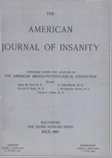14. EXPERIMENTAL HISTOPATHOLOGICAL RESEARCHES ON INSULIN SHOCK
Abstract
In dogs which are given a few shocks close together and which die in insulin coma there are observed very acute, diffuse, edematous alterations which are very probably reversible. Butthere are observed also in many neurons (cells and fibers) very severe irreversible changes with wide distribution. Moreover, at certain spots there are more or less advanced areas of necrotic destruction of the nervous elements, with productive reaction on the part of the vessels.
In dogs which are given many shocks close together and which do not die in insulin coma there are noted on the whole analogous manifestations except that the acute edematous changes are found to be less diffuse. But the areas of cellular rarefaction are still encountered. They often involve different layers of the cortex and are not infrequently sharply bounded by less damaged areas of cortex, in which the architecture of the parts is recognizable.
Such sharp demarcation suggests that these areas are related to circulatory disturbances. This relation is very important from the physiopathogenetic point of view so that further study will be necessary and is now being contemplated.
We may conclude from these researches that in dogs the therapy with repeated insulin coma not only brings about the destruction of a certain number of cortical neurons scattered here and there (presumably the less resistant neurons higher in the evolutionary scale), but also causes the production of patches in which along side of the destruction of specifically nervous tissue, there is a lively proliferative reaction on the part of both neuroglial tissue and blood vessels.
Access content
To read the fulltext, please use one of the options below to sign in or purchase access.- Personal login
- Institutional Login
- Sign in via OpenAthens
- Register for access
-
Please login/register if you wish to pair your device and check access availability.
Not a subscriber?
PsychiatryOnline subscription options offer access to the DSM-5 library, books, journals, CME, and patient resources. This all-in-one virtual library provides psychiatrists and mental health professionals with key resources for diagnosis, treatment, research, and professional development.
Need more help? PsychiatryOnline Customer Service may be reached by emailing [email protected] or by calling 800-368-5777 (in the U.S.) or 703-907-7322 (outside the U.S.).



